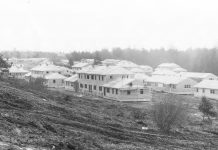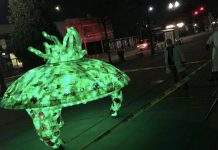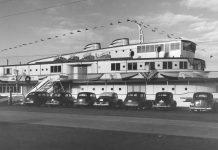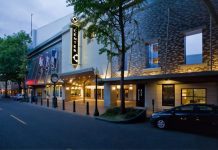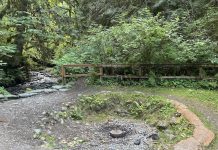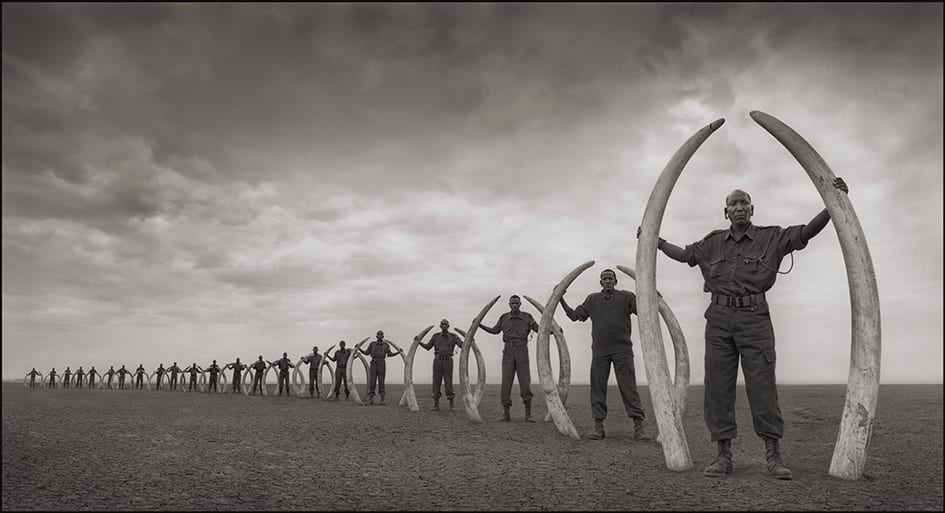There is still time to see remarkable Endangered Species artworks in Bellingham before they disappear.
It is a subject close to the heart for many in the Pacific Northwest and throughout the nation. In 2013, curator Barbara Matilsky launched Whatcom Museum’s Vanishing Ice exhibit. It went on tour internationally for five years after closing in Bellingham.
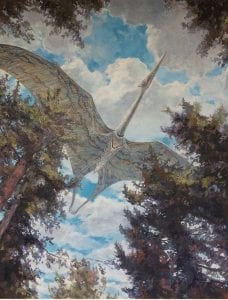
“Vanishing Ice dealt with climate change and didn’t have a lot of images of people or animals,” says Matilsky. “Obviously, the poles and the alpine regions have some life to them, but it was mainly the ice and landscape that was of concern in that exhibition and I thought, ‘there’s another part of the story that’s missing here.’”
And that’s how the door to what would be become the Endangered Species exhibit cracked open.
Matilsky has been an art curator for over 30 years after receiving her PhD in art history at the NYU Institute of Fine Art. Her Endangered Species exhibit asks patrons to consider what has happened to life on earth, both as a result of climate change and through natural phenomenon. Matilsky reads the comments that are left by patrons and thinks about how her work impacts them. “It’s saddening people – and it’s waking them up,” she says. “It’s also motivating them to do something.”
This is her passion, she says. Her dissertation was on the sublime in 19th century French landscape painting, specifically alpine and polar landscapes, which also focused on the relationship between artists and natural scientists. She’s been at this a while. Matilsky’s knowledge and care shine in this latest exhibit.
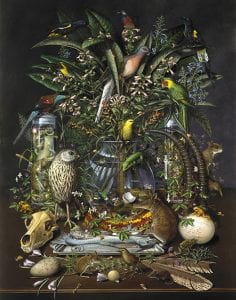
Gone, from the Taxa series, 2004. Oil and alkyd on canvas over panel. 48 x 36 in. Photo courtesy: Whatcom Museum
Patrons enter to a timeline of conservation history. There’s a chance to orient the self in time, to consider where we stand at the present moment in the context of the greater effort of conservation. “I think it’s really important for people to know there’s a long legacy of artists, natural scientists and conservationists who have been concerned about loss of life on the planet since humans emerged, more or less,” Matilsky says.
She uses her expert knowledge and industry connections to craft an experience. “I tell a story,” she says. From the conservation timeline, visitors begin to see the narrative emerge. Matilsky calls the first section “a celebration of beauty and complexity and the idea of the artist as naturalist – and the naturalist as an artist.”
The exhibition features 60 artists, each with a different approach to concepts of conservation. Christy Rupp, for example, recreates the skeleton of the extinct great auk using the bones from industrially raised chickens. Isabella Kirkland, in her piece Gone, includes 63 extinct species in one extraordinary painting. Patrons are invited to linger with the work as Gone includes an extensive key through which to explore species unknown to many.
Matilsky took a multi-disciplinary approach to the exhibit. In addition to artists, poets and writers, she drew from natural science, history and conservationists. “I do a lot of research; I find out what the issues are, what the history is,” she explains. The work is selected by direct contact with artists, by reaching out to peers and other curators, and through deep investigation.
Naturally, mass extinction plays a role in the exhibit as well, both in the past tense and the present. “I thought it was important for people to understand that it’s a phenomenon that exists in nature, but right now it’s happening at accelerating speeds,” Matilsky says.
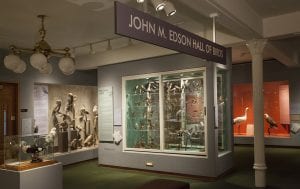
An entire section on extinctions includes the aforementioned great auk alongside the passenger pigeon and the dodo bird, or en masse, as in Gone.
The causes for endangerment are of particular interest. Matilsky says these can best be remembered through the acronym HIPPO: habitat loss, invasive species, population growth, pollution and over hunting/over harvesting. The exhibit is arranged to move through this pneumonic, systematically revealing each of the primary causes.
Striking highlights will undoubtedly leave a lasting impression, such as Nick Brandt’s images of men holding ivory tusks, David Chancellor’s photograph of the trophy hunter’s room of preserved and mounted animals, or the stunning videography of the statuary becoming a coral reef in John deCaires Taylor’s Vicissitudes.
Matilsky had one objective, she says, “To inspire. To use the art to inspire people to pay attention.”
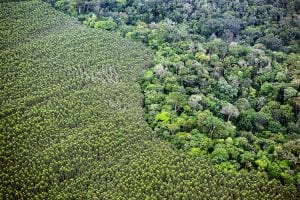
the Japanese and European paper making industries, 2017. Archival digital print. 40 x 60 in. Photo courtesy: Daniel Beltrá
So it’s not all doom and gloom. Matilsky is careful to point out that much good is happening, such as the work of Xavier Cordata who has a habitat restoration project called “The Reclamation Project,” which is working to restore mangrove forests. They’ve already restored over 25 acres along the coast of the Florida Keys around Key Biscayne. The Frost Science Museum has adopted the project, details of which can be seen in the endangered species exhibit.
Matilsky herself says it best, “It’s just amazing to me. So many people are doing something in their own way to make change. And I think that the more this happens, the more we will move in the right direction.”
This exhibit opened at the Whatcom Museum in September and will remain through Sunday, January 6. Entrance into the museum includes an entire day of art immersion as patrons are also invited to tour the now permanent People of the Sea and Cedar exhibit, which features Coast Salish indigenous culture through time, as well as the Family Interactive Gallery (FIG) which features hands-on fun for kids.
Entrance fees also include entry to the historic building on the museum campus, Old City Hall, with exhibits of local interest, such as The Hall of Birds, and even tie-in exhibits to the main hall, such as an ivory exhibit, which coincides with the Endangered Species feature at the Lightcatcher building. The Endangered Species and Coast Salish exhibits are both located in the Lightcatcher Museum on Flora Street, downtown.
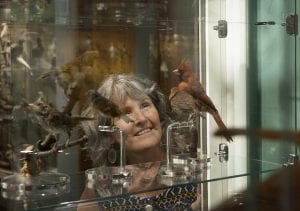
The museum is open Wednesday through Sunday, 12:00 – 5:00 p.m. Check their website for holiday closures.
Bellingham is filled with unique museums and galleries to explore. While you’re in town, pay a visit to Spark Museum. This local treasure recently won Bellingham’s 2018 Tourism Business of the Year and their new exhibit The War of the Currents explores the fascinating links between Thomas Edison, Nikola Tesla and George Westinghouse from 1880 – 1893.
The fall and winter months are also a great time to find a variety of Bellingham lodging options at off-season rates. For more information contact the Bellingham Visitor Center at 360-671-3990, tourism@bellingham.org, or visit Bellingham.org.
Other Whatcom Museum Exhibitions Coming in 2019 Include:
Washington Remembers WWII: Their Sacrifice. Our Freedom.
January 16 – April 14, 2019, Old City Hall
The Legacy Washington exhibit was created through the Office of the Secretary of State to honor the tens of thousands of Washingtonians who served in the war. In addition to the Legacy stories, the exhibit will highlight a variety of WWII artifacts, documents and historic photographs from the Museum’s collection.
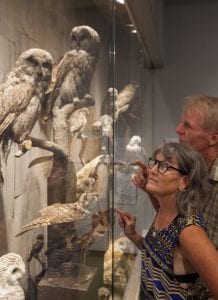
Bellingham National 2019 Juried Art Exhibition and Awards at the Whatcom Museum
February 2 – May 19, 2019, Lightcatcher building
Juried by Bruce Guenther, Independent Curator and Art Historian
The Whatcom Museum is hosting the third Bellingham National 2019 Juried Art Exhibition and Awards. Artists from around the country submitted artworks on the theme of “water’s edge” to be considered for this exhibition. The top three artists will receive cash awards and the exhibition will include a popular choice award.
Modern Quilts: Designs of the New Century
June 1 – August 25, 2019, Lightcatcher building
Curated by Riane Menardi, Alissa Haight Carlton and Heather Grant of the Modern Quilt Guild.
Experience the power of modern quilts firsthand in this exhibit of 60 innovative and inspiring quilts that represent the best of the past decade. In this exhibit, you’ll see the work of modern quilters past and present, and learn the story of modern quilting from its earliest roots and influences through today.
Sponsored





